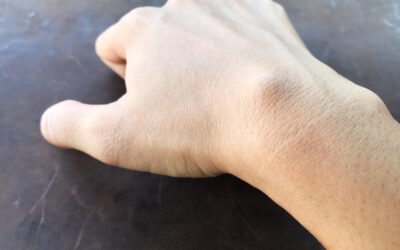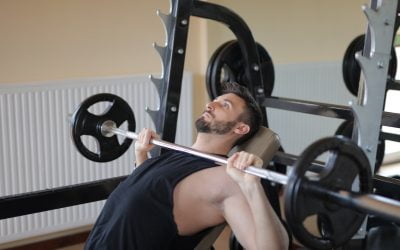If you’ve sprained your wrist, you know it can be quite painful and difficult to move around normally. But the sooner you begin sprained wrist exercises, the faster you’ll start to see improvement in how your wrist moves and feels. Here are some of the best sprained wrist exercises that will help improve range of motion and speed up recovery time.
Anatomy of Wrist.
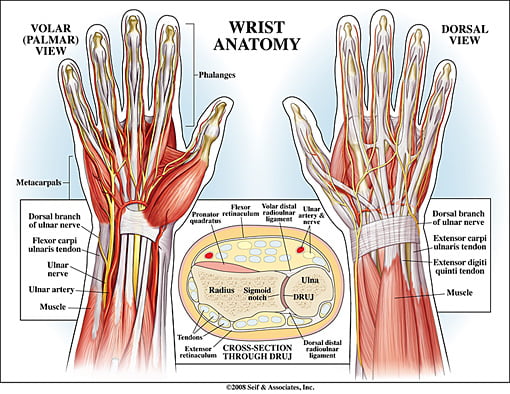
The wrist is a complex joint made up of many bones and ligaments. The scaphoid bone and triquetral bone form the carpal tunnel which protects the median nerve, one of the most important nerves in your body.
This nerve helps control movement in your thumb, index finger, middle finger, and half of your ring finger. The lunate bone is also part of the wrist joint. If these bones are sprained or fractured then it can be difficult to move your hand and fingers.
What is Sprained Wrist?
A sprain is a type of injury that results when the soft tissue, such as ligaments and/or tendons in your wrist, gets overstretched or torn. When this happens, the blood supply is cut off which makes it difficult for the sprained area to heal.
Additionally, if you’re not careful with how you use your hand after a sprain, it can actually worsen the injury and make it more difficult for you to recover.
Causes of Sprained Wrist.
A sprained wrist occurs when a bone or joint in the hand is twisted, causing ligaments and tissues in the wrist area to stretch too far. It is often caused by slipping and landing on an outstretched hand, or from falling onto an outstretched hand.
The force can also come from twisting the arm while trying to break a fall with the other arm. A sprain is graded based on severity and can range from grade 1 (mild), grade 2 (moderate), or grade 3 (severe).
Symptoms of Sprained Wrist.
A sprained wrist is the result of an injury or trauma. Symptoms include pain, swelling & bruising in the affected area.
Treatment for Sprained Wrist.
1. Ice Pack.
One of the most common ways to treat a sprain is by using ice. For best results, use it as soon as you can after the injury, at least every two hours for up to three days.
Use an ice pack or a bag of frozen peas wrapped in cloth and placed on your injured area for about 20 minutes at a time. Make sure the cold doesn’t come into contact with any other body parts, especially your skin near the injury because this could cause frostbite.
If you can’t get an ice pack, hold some ice cubes in a washcloth or towel and apply them gently on your injured area for 10 minutes at a time.
2. Non-steroidal Anti-inflammatory Drugs (NSAIDs).
NSAIDs are available over-the-counter (OTC) and can help relieve pain and swelling at the site of injury after a wrist sprain. Examples of NSAIDs include ibuprofen (Advil) and naproxen sodium (Aleve). While not common, prescription strength NSAIDs may be recommended to maximize anti-inflammatory effects.
3. Wrist Band.
Wearing a wrist band can help reduce excessive movement of joints and sudden or unexpected use of the wrist that can lead to sprains.
4. Physical Therapy.
Physical therapy assist to build strength, improve flexibility, and enable functional movements in the wrist. Exercise should always be done within the tolerance limit. A trained physical therapist can help prepare a exercise plan for the sprained wrist based on the level of injury.
*Note. It is advisable not to return to work or play unless advised to do so by the doctor. Excessive stress on the ligament can prevent healing or cause further injury.
Benefits of Sprained Wrist Exercises.
The benefits of sprained wrist exercises are;
- Ease arthritis symptoms.
- Reduce pain.
- Build strong wrists.
Best Sprained Wrist Exercises.
Stretching Exercises.
1. Wrist range of motion.

- Flexion: Gently bend your wrist forward. Wait for 5 seconds. Set 2 of 15.
- Extension: Gently tilt your wrist backwards. Hold this position for 5 seconds. Set 2 of 15.
- Side by Side: Gently move your wrist from one side to the other (handshake motion). Stop for 5 seconds in each direction. Set 2 of 15.
2. Wrist Stretch.
Press the back of your injured part of your injured arm with your other hand to help bend your wrist. Pause for 15 to 30 seconds.
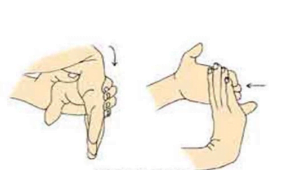
Thereafter, press the fingers of the hands in the back direction and pull the hand backwards. Pause for 15 to 30 seconds. During this exercise, keep the hand straight on your injured part.
Practice for 3 sets.
3. Extended Wrist Stretch.
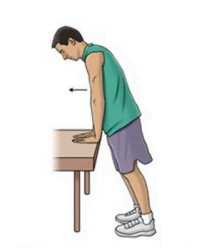
Stand near the table with your palms down, fingers flat and elbows straight. Bend the body weight forward. Hold this position for 15 seconds.
Repeat 3 times.
4. Wrist Flexion Stretch.
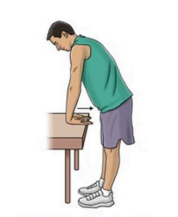
Stand near the table with palms keeping down, fingers pointing at your body, and elbows straight.
Lean away from the table. Hold this position for 15 to 30 seconds.
Repeat 3 times.
5. Forearm Pronation and Supination.
Bend the elbow of your injured hand at 90 degrees, keeping your elbow on your side. Raise your palm and pause for 5 seconds. Then slowly lower your palm and pause for 5 seconds. Make sure you keep your elbows on your side while exercising and bend 90 degrees.
Set 2 of 15.
When this exercise becomes painless, do it with some weight in your hand such as a soup box or hammer handle.
Strengthening Exercises.
1. Wrist Flexion.
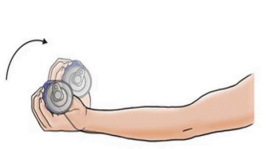
Hold a can or hammer handle in your hand while keeping your palm upwards. Bend your wrist upwards. Slowly lower weight down and return to the starting position.
Set 2 of 15. Gradually increase the weight of the can or weight you hold.
2. Wrist Extension.

Hold a soup can or small weight in your hand with your palm facing down. Raise your wrist slowly. Lose weight slowly in the starting position.
Set 2 of 15. Gradually increase the weight of the object you are holding.
3. Grip Strengthening.
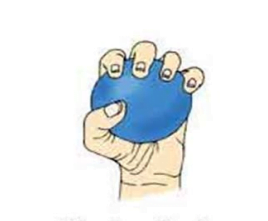
Squeeze a soft rubber ball and squeeze for 5 seconds. Set 2 of 15.
4. Curls.
Use your opposite hand to help you curl your sprained wrist up and down, 20 reps on each side.
5. Clenches.
Make a fist with your injured hand, then use your other hand to squeeze it. Repeat this exercise 10 times.
6. Wrist Circles.
Hold both arms out in front of you and slowly rotate the left arm clockwise while rotating the right arm counterclockwise, 10 times on each side.
Points Keep in Mind During Exercises.
- Don’t apply pressure to your wrist.
- Avoid using your wrist for things like gripping, squeezing, and turning objects.
- Keep your hand elevated when you can, so that the blood flow is restricted from entering the injured area of the wrist and causing swelling and pain.
- Try splinting your hand with a small piece of cardboard, such as a cereal box or cracker package, so that you can use both hands freely while still protecting your sprained wrist from further injury or overuse.
- Apply ice packs intermittently on the affected area for 15-20 minutes three times a day (every four hours).
Home Remedies of Sprained Wrist.
There are several ways you can help treat your sprain at home without a doctor’s visit. These are;
- Place a bag of ice over the sore area for 15 minutes every hour.
- Prop up your arm with pillows when sleeping for at least three days following your injury.
- Over-the-counter pain relievers like ibuprofen or acetaminophen.
- Wearing a wrist brace if you continue experiencing pain after 48 hours of icing.
Ways to Reduce Pain.
There are many ways through which you can reduce pain from a sprained wrist, including:
- Rest the arm or hand in a sling or immobilizing brace.
- Use an ice pack on the injury for 15 minutes at a time.
- Take acetaminophen (Tylenol) or ibuprofen (Advil) if your doctor has prescribed it.
- Use heat packs on the injury for 15 minutes at a time. If you want to take any other medications, consult your physician first.
- Apply compression by using ace bandages and elastic wraps. Tighten them enough so that they compress but not so tight that they cut off circulation. Change them every day or as needed to keep them clean and dry.
- If swelling is present, apply ice instead of heat until the swelling goes down and then switch back again after 10-15 minutes of icing. Swelling will also reduce more quickly with elevation than without it; either resting with your hand elevated above heart level or raising it with a bag of peas will do this job nicely for about 30 minutes at a time.
Frequently Asked Questions.
After the recovery from the treatment while pain slowly fade away at that moment it is recommended to start exercising.
To speed up healing, you can:
(a) Apply ice to your wrist to reduce pain and swelling.
(b) Take anti-inflammatory painkillers.
(c) Rest your wrist for at least 48 hours.
(d) Press the wrist with a bandage.
(e) Raise your wrist over your heart on the pillow or behind a chair.
(f) Use a cast or splint to keep your wrist steady.
Usually it takes up to 2 to 10 weeks to recover. However, it may differ according to the severity.
It is recommended to take rest, use ice compress and anti-inflammatory painkillers. However, if symptoms still persist then it is recommended to consult with your doctor.
It is recommended to consult with your doctor when the pain is still persist more than 2 weeks and gradually increase.
Bottom Line.
When you’re caring for a sprained wrist, the most important thing is to keep the joint as stable as possible. The best way to do this is by using splints and braces. When you’re immobilizing your sprained wrist, it’s important that you do so in a comfortable position. Avoid resting your arm on any hard surfaces or leaning back in an awkward position. By following these simple rules and doing the exercises outlined above, you can recover from a sprained wrist quickly and easily.

 Workout
Workout
 Meditation
Meditation


 Stories
Stories


 Podcast
Podcast E-book
E-book

